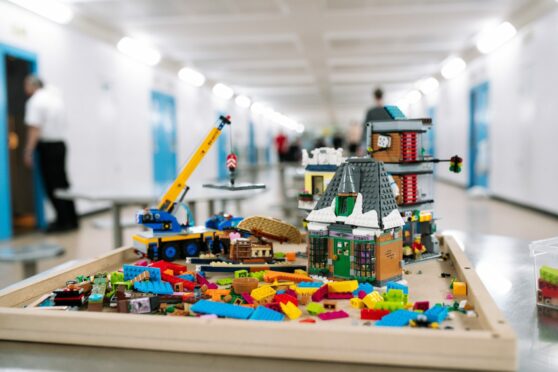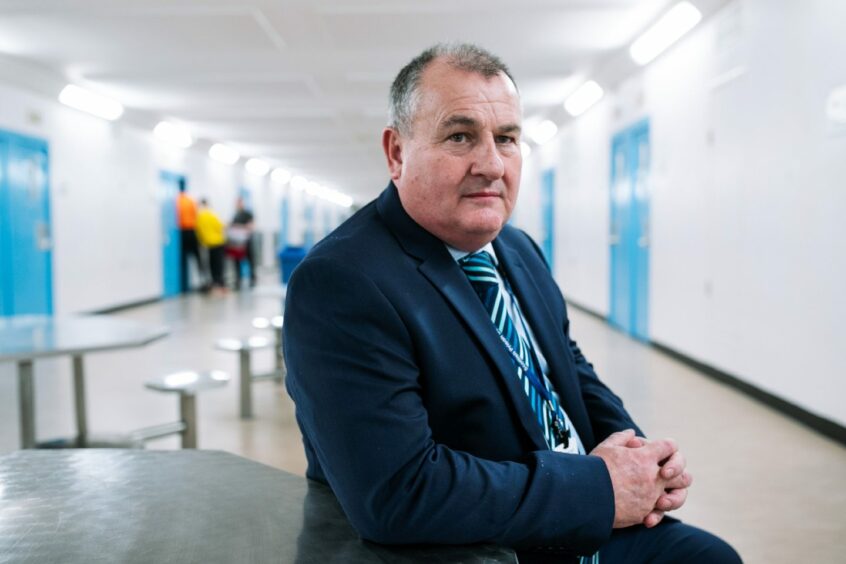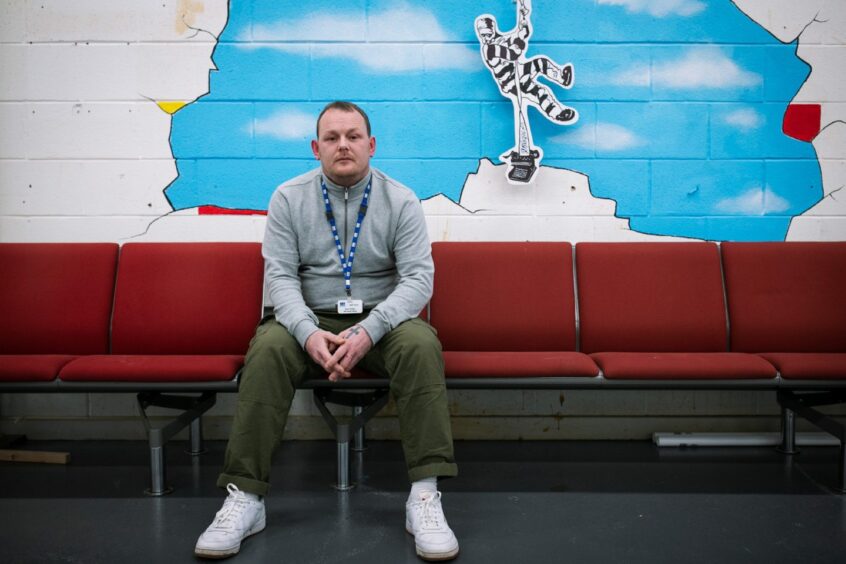
As any parent who has ever stood on one knows, Lego’s tiny bricks can get everywhere but, even so, seeing the brightly coloured plastic in the middle of one of Scotland’s Category A jails is still a surprise.
Andy Hodge, the governor, also admits being a little taken aback at first but says the iconic toy is far more than child’s play for the men held at Perth Prison and is just one signal of a new kind of incarceration being pioneered there.
He is driving moves towards a more progressive regime where being held behind bars is the punishment but what prisoners do there is just as important if Scotland is to break the cycle of crime and incarceration. Hodge said: “We want to transform Perth into a recovery-orientated establishment. It is no longer about doing things to people, it is about doing things with people.
“We made a number of changes during Covid to cope with the changing restrictions and there have been huge benefits. We have kept these changes as they have benefited everyone – residents and staff. Before Covid, like most prisons, during the day people would work or do their activities and then there was a period of association where people played pool or table tennis and that kind of thing.
“Covid changed all that. People had to be kept apart to prevent the potential spread of the virus and were locked up for most of the day out of necessity.
“Unfortunately, we lost two elderly residents at the start of the pandemic who had underlying health problems. It was a tremendously challenging time here as it was for the whole world. We just had to change the way we did things coming out of that.”
The Lego is just one small part in the new kind of thinking at HMP Prison Perth, one of Scotland’s oldest jails, originally built to house French soldiers and officers during the turmoil of the Napoleonic Wars.
It has its own place in Britain’s penal history becoming, in 1870, the site of the first execution behind closed doors when George Chalmers was hanged within its walls. Public executions had been abolished two years before. At the start of the First World War, it was the only jail with the facilities to force-feed hunger-striking suffragettes.
Now, the jail is one of the first in Scotland to use Lego therapy to boost confidence, communication and social skills of prisoners with the scheme set to be rolled out across the country. Hodge said: “I had never heard of Lego therapy at all and thought, ‘what’s that all about?’ But it has been a real eye-opener.
“The guys are really enjoying it. There are some people here who have never been rewarded and never had someone say to them, ‘well done, that was a success’.
“It is all about giving people choices, getting people in the right direction and supporting them on that journey. There are some who will say that we should lock everyone up and throw away the key but history shows that does not work. We need to do things differently now.
“Other prisons have been looking at the Lego project and seeing if they could do something similar in their own establishments.”
Lego therapy was pioneered by Canadian neuropsychologist Daniel LeGoff and was designed to support children with autism and communication challenges to develop skills in language and collaboration.
Dr Sandra Wheatley, a chartered member of the British Psychological Society, said: “It is a new one on me but one of the therapeutic things about Lego is the sense of immersion one gets. It gives you the ability to lose yourself in something, to focus entirely on one thing. As a distraction that can be phenomenally useful. It is something that we use in cognitive behavioural therapy for clinical things such as depression and anxiety.
“It sounds like a small thing but to get a reward, a sensation of achievement, to feel that you have done something that you can be proud of, that is something that we get all through our lives.
“In a prison, to get praise from people you perceive as your peer group and also from people you perceive to be in authority is a very powerful thing. It is a brilliant, clever idea to have this in the prison. It is accessible, replicable and it’s fairly low cost. It can be done in an institutional setting and it has therapeutic value.”
Perth holds on average 678 prisoners with the population including men on remand and people serving short-term sentences of less than four years up to those serving life sentences.
The changing culture in Perth has emerged as other Scottish jails were criticised for cutting down “purposeful activity” for prisoners with the Scottish Conservatives flagging a drop in the number of hours prisoners spent working, training or studying, so-called “purposeful activity” intended to help lead to improving chances of released prisoners finding jobs and their life skills.
During our tour of the prison with Hodge and his senior staff, The Sunday Post visited new facilities including a social hub, a bike repair workshop which works with external charities, a recovery café for people battling addiction, and a learning centre.
The staff referred only to residents, never prisoners or offenders, signalling a cross-border break in terminology, with UK Justice Secretary Dominic Raab reportedly banning prisons in England and Wales from referring to “residents” or describing cells as “rooms”.
Whatever they are called, last June, a report by the prisoner-led charity User Voice and Queen’s University Belfast suggested 85% of prisoners were locked up for at least 23 hours a day during the pandemic. This was blamed for surging levels of anxiety, depression, self-harm and mental illness. Nearly 60% of prisoners surveyed had not had a family visit during lockdown, while 78% said they had gone at least six months without a visit.
During the outbreak, some prisons were at breaking point as support services largely disappeared and gym, education and family visits stopped.
But Hodge described how the unprecedented challenges of Covid had been used to forge a new way of operating inside the Perth jail. He said: “I worked in prisons for decades and I am old enough to remember slopping out. There needed to be a real change. The old ways didn’t work.
“Covid and its aftermath gave us the chance to move towards a new way of doing things here. At one point, one of the prisoners said to me, ‘when was the last time you played table tennis?’
“I couldn’t remember the last time I played it. Hanging about in the evenings with residents just playing pool or table tennis was making people bored and it could potentially lead to trouble. It’s not what you would do on the outside, it wasn’t natural.
“On the outside, people go to work during the day then go to a concert or take part in your hobbies or interests in the evening.
“We wanted to recreate that. We wanted to have positive engagement where people learn and grow and are actively engaged with what they are doing.
“We asked people what they wanted to do, what would help them. Some of the answers surprised me but they have made a great, positive difference.
“We now have things like our own radio station which transmits across the prison, a social hub, a recovery café and pet therapy where residents look after hens and bees.
“We are the only prison building on that positive engagement. So far, we have had 5,265 evening activity hours and this is just the beginning.”
‘I swore I would never be back in jail but now I love coming’
He is, according to Euan Rutter, the “ultimate poacher turned gamekeeper”.
He served time as an inmate at HMP Perth but is now back there as a lived experience peer support worker.
Rutter, 37, used art to get away from a life of addiction and crime and now he works in the prison to help others do the same.
He said: “I can relate to people here as I have that lived experience. I have been through heroin addiction and I have been in recovery. From 2008 to 2013 I was a resident here. I am now doing my Master of Fine Arts and I hope to get my PhD.
“It felt like being the ultimate poacher turned gamekeeper when I started. You always have first-day nerves when you start any job but I did feel anxious about coming back here.
“But one of the guys said to me that this was different, I was coming back for all the good, positive reasons. It has been brilliant. The guys have really been engaging with art and getting involved. Art can be useful when it comes to dealing with trauma, recovery
and therapy.
“In my first week in the job my anxiety was through the roof because I swore I would never be back in prison but now I love coming to work and seeing the benefits it brings people. It has been quite a journey.”

Enjoy the convenience of having The Sunday Post delivered as a digital ePaper straight to your smartphone, tablet or computer.
Subscribe for only £5.49 a month and enjoy all the benefits of the printed paper as a digital replica.
Subscribe © Andrew Cawley
© Andrew Cawley © Andrew Cawley
© Andrew Cawley